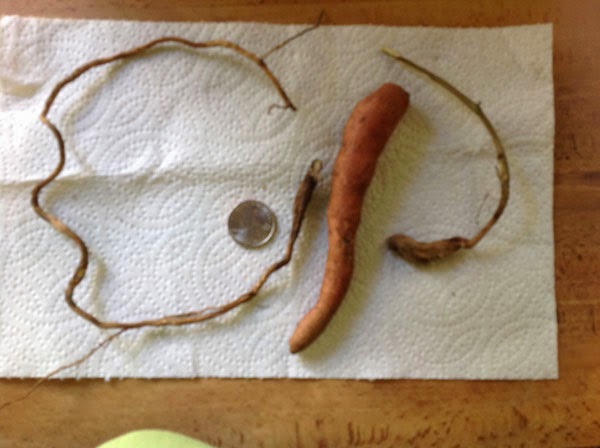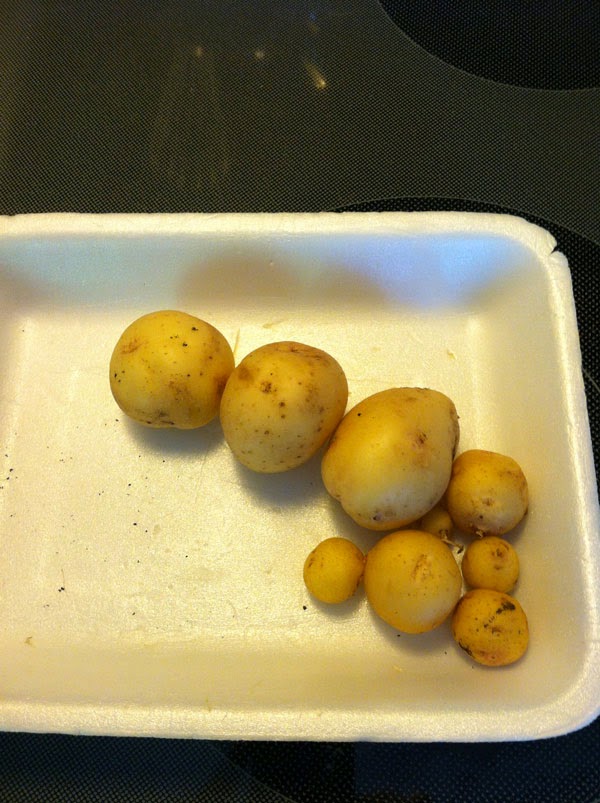Hi, David- I haven't been following your blog for long, but I really enjoy it and have found it very encouraging. You grabbed me with the one on two blocks- 17 edibles and I have been a real fan since. I started as a "real food" foodie, but since there is quite a bit of overlap with the prepper/self-sustainable community I have found that I fit into that one as well. I am hoping that you can offer some advice. I am in the greater Orlando area. I have put in a backyard garden for the last couple of years that I can't really call successful, but this one was a disaster. I started early, some from seeds others from plants. Got a pretty good crop of bush beans, 3 bell peppers, 8 tomatoes (from 6 plants), no cantaloupes (many blooms, no fruit), no watermelons, no garlic (3rd try), a few microscopic potatoes (see pic below- had more seed potatoes than that), carrots? (See below pic), onions- lots of green tops that never did anything (see pic), and I just dug up the sweet potatoes- none from what must have been 200 ft of vine (see first pic below). I really need some direction here- not sure what I'm doing wrong. Any advice? The goal of self-sufficiency has diminished to just a hope that I could get a few veggies. Please help! D. L.
Pictures:
We have a conundrum here.
In a follow-up e-mail from D. L., she wrote:
On a whim I kept track all last year of every edible we purchased- just to see what would be the best things to grow that we clearly like. I'm almost embarrassed that between the two of us we went through 35lbs apples, 50 lbs bananas, 37 lbs grapes, 25 lbs peaches, 8 lbs carrots, 20 lbs onions, 30 lbs of various kinds of potatoes and about 45 tomatoes. It's not quite as bad as it sounds since I am a big canner. We had my 8 yr old grandson every Friday during the summer and planted some popcorn (on a whim- in college we had a leaky window and when a roommate spilled the popcorn some started growing in the living room- avocado green shag- carpet) just to see what it looked like along with some green peanuts. The corn got about 3 ft high before it gave up the ghost, but the peanuts still appear viable... I'm demoralized enough without thinking about the that. Honestly, I used to have a green thumb.
Any time you move to a new growing region, no matter how good you were in your previous location, you’re going to face challenges. When I went from gardening in South Florida to gardening in Tennessee, I was lost for a while. Eventually I hit my stride, however.
(Interesting, the natives used to grow their popcorn on shag carpeting before the white man pulled it all up and put down laminate faux-wood tiles. True story.)
Let’s attack the crop problems one at a time. D. L. mentions first that she had a “pretty good crop of bush beans.”
That’s not surprising. Many bush beans do very well in Florida. Now – if you want to go from “pretty good” to “holy moly” bean yields, put up a big trellis and plant snake beans.
Next crop: bell peppers. She writes that she only got three.
I wouldn’t worry about that. You’re lucky to get any. I’ve met people that claim they do great with bell peppers here in Florida; however, my experience with them has been the opposite. They’re needy, picky, pain-in-the-neck plants. I wouldn’t bother. Hot peppers grow like weeds here (in fact, I’ve had them pop up in my yard and grow without care). If you can’t take the heat, try planting some sweet peppers that aren’t bell types and see if they do better. Even John from GrowingYourGreens.com doesn’t plant bell peppers anymore.
Tomatoes: 8 from 6 plants? There’s another tale that surprises me not. Most larger tomato types fail in Florida unless you plant them at just the right time, under the right conditions, when you see a raccoon howling at a perfect supermoon. They can be grown well – I have a friend that does wonderfully – but I would skip all the big types and just plant cherry varieties. They’re much better suited to our climate and rainfall. Yellow pears do well also, but the flavor is bland.
I’m not sure what happened with your cantaloupes and their lack of fruit. Sounds like a bee deficiency. Might be the same problem with the watermelons. I’d try watermelons again, but cantaloupes haven’t done the best for us here either.
Garlic is another crop that’s not well-suited to Florida. We get some yields but they’re poor. Finding varieties is the key: some types are better for the south, others for the north. I would research “garlic for hot climates”. Also, fall planting works: spring doesn’t.
Potatoes aren’t the best root crop for Florida, though you will have luck some year. Russet types have done the best for me but between the heat and the fire ants… well…
Carrots and onions have performed much better for me as fall crops than spring crops. The heat knocks them out quickly. They don’t like to set roots.
Finally – sweet potatoes. That’s a sad tale. Apparently, if you keep pulling up the vines and throwing them back so they don’t root as much along their nodes, they’ll concentrate on the main root clump at their center. Also, they may have been too well fertilized. Since all of your root crops have done badly, I’d consider adding bone meal to your garden in the future and seeing if that helps.
Without seeing your soil or how your growing your crops, it’s not easy to pinpoint exactly what’s going wrong with everything, yet the most obvious failure seems to be in varieties chosen. Raised beds are also not helpful in our fast-draining soils.
Since we’re subtropical, not temperate, it’s a good idea to look south for vegetables, not north.
You’re going to have to get creative in your cooking but it’s an adventure!
Here are a few suggestions to replace your failing crops:
ROOTS
Ditch the potatoes and plant cassava, malanga and true yams. They’re all tasty and will fill the same niche in your cooking that potatoes fill. They’ll also consistently succeed! I’d also try sweet potatoes again. Instead of onions are garlic, think about planting garlic chives and using those for cooking. The flavor is excellent and the plants are perennial.
VEGETABLES
Cherry tomatoes (Everglades cherry tomato is one excellent type), Seminole pumpkin (if you have space), perennial cucumber (Coccinia grandis) if you can find it – ask around at Indian markets if anyone has a plant. In winter: mustard, collards, kale, turnips. Also plant snake beans, edible hibiscus, Surinam purslane and other tropical species.
FRUITS
Florida, for the most part, wants to be forest. Consider adding some tried-and-true trees that will yield happily for you. Mulberries (dwarf, if you can’t fit in a big one) are the best berry I’ve ever grown. Japanese persimmons are rich and delicious. Loquats are a very good fruit for canning and drying. Figs do very well, and Raja Puri bananas should thrive in your area. Pineapples are easy to grow with a little protection.
Good luck.
Finally – does anyone else have some suggestions for D.L.? Leave a comment and let her know.
Shop at Amazon and support Florida Survival Gardening





4 comments
D.L.
I am at best a half-arsed gardener. Most of my gardening expertise comes from viewing my friend David's blog here and going "I could try that" or "No way… too much work". So if I can do it, you can too. I have managed to grow decent carrots, potatoes and beets. I've had varying success with tomatoes, but very little with bell peppers. I live about halfway between David and you, so climate is similar.
Seems like Florida soil just needs LOTS of biomass and compost. Also, read about our (mine and David's) biochar experiments here on the blog.
For most of these things, my best results were either in deep pots or hugelkultur beds. The pots were very large, deep ones filled on the bottom with leaves, old wood (oak, not pine) and biochar, then a layer of fresh clipped grass or other greens (nitrogen), and then about a foot or two of heavily composted soil on top. Some of these pots are literally 3 feet wide and 2 feet tall. I also kept most of my "northern" type veggies in a half-shaded area. Carrots did quite well in that deep soil. Lots of times I doubled up in the pots, putting a leaf veggie in the middle and surrounding it with a ring of carrots or beets.
I also didn't waste time planting seedlngs in one place and then transplanting them into the pots. I lose at that game. So I just put a layer of the finest compost at the top, sprinkled seeds in, and then sprinkled a very thin layer of compost and fine grass clippings on top. Keep moist but not soaked. Wait.
The hugelkulter beds were at least 2 feet deep and filled with oak, cherry, a little pine here and there, and charred wood or charcoal (not commercial charcoal!).
Potatoes did best in an older garden bed that had several years of composting, biochar and manure thrown around, and had grown several other crops, including pumpkins and okra (okra does great here, BTW). Pumpkins seem to really help the soil.
My neighbors grew an incredible sweet potato crop just by composting and adding cow manure from a neighboring field. They had so many they had to give them away all over the neighborhood. I mean, they had sweet potatos as long as my forearm! So don't listen to David–he lies!. They can do quite well here. But, be careful of the manure source.
I would also add Seminole pumpkins, butternut squash, and okra. And get your soil tested for nematodes!
I live in St. Petersburg, near the beach, and my soil is really just glorified sand. I find that my best “crop” is star fruit. I planted a tree that was as tall as me, which cost about $30 if I recall. It grew well immediately. By the second year it had some star fruits on it. Now, about 3-4 years out, I am swamped in star fruit, and the tree is about 18′ high and growing like a weed. Last year I got some free tree mulch from a tree trimmer (a truck load) and covered the ground around the tree about 5″ or more. The trimmings had leaves in it, too. I also have been tossing fish water out around it, from tuna cat food cans I rinse out. Trees in general seem to do better than gardens, as they can go deeper for nutrients and water. I think that mulching deeply for both gardens and trees is extremely important to discourage weeds, insects, and keep the soil moist. Oh, by the way. There are two types of star fruit, tart and sweet. Look for the sweet types, as they taste great.
“Trees in general seem to do better than gardens, as they can go deeper for nutrients and water”
Yes! I make that point repeatedly in my book Create Your Own Florida Food Forest. Why work so hard?
And I agree on star fruit. We planted one in The Great South Florida Food Forest Project a few years ago and I’ll bet it produces 100lbs a year. It’s the sweet type. I’ve hard tart ones… not nearly as refreshing.
Comments are closed.